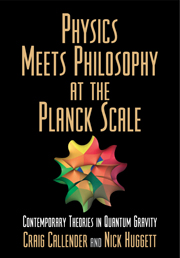Book contents
- Frontmatter
- Contents
- Preface
- 1 Introduction
- Part I Theories of Quantum Gravity and their Philosophical Dimensions
- Part II Strings
- 5 Reflections on the fate of spacetime
- 6 A philosopher looks at string theory
- 7 Black holes, dumb holes, and entropy
- Part III Topological Quantum Field Theory
- Part IV Quantum Gravity and the Interpretation of General Relativity
- Part V Quantum Gravity and the Interpretation of Quantum Mechanics
- References
- Notes on contributors
- Index
6 - A philosopher looks at string theory
Published online by Cambridge University Press: 15 December 2009
- Frontmatter
- Contents
- Preface
- 1 Introduction
- Part I Theories of Quantum Gravity and their Philosophical Dimensions
- Part II Strings
- 5 Reflections on the fate of spacetime
- 6 A philosopher looks at string theory
- 7 Black holes, dumb holes, and entropy
- Part III Topological Quantum Field Theory
- Part IV Quantum Gravity and the Interpretation of General Relativity
- Part V Quantum Gravity and the Interpretation of Quantum Mechanics
- References
- Notes on contributors
- Index
Summary
Before we, as philosophers, take a look at string theory I want to mention that more than one person has suggested to me that it is still too early for philosophical and foundational studies of string theory. Indeed, the suggestion emphasizes, since string theory is still in the process of development, and its physical and mathematical principles are not completely formulated, there is, in a sense, no theory for the philosopher to analyse. And I must admit that I think there is something to this suggestion. In a sense I hope I will make clear, there does not yet exist a precise mathematical formulation for string theory as there is Hilbert space for (elementary) quantum theory, and Riemann spacetime for general relativity. Because these latter formulations exist, we can ask precise questions and prove precise theorems about their interpretation. The Kochen–Specker theorem about non-contextualist hidden variable theories, the Fine–Brown proof of the insolvability of the quantum measurement problem, and the current determinism–hole argument debate are some examples. Without a clearly formulated mathematical structure, I don't think we can expect to get analogous distinctly stringy results.
This suggests a related worry. String theory, at least in the first quantized theory, is a relativistic quantum theory of strings (one-dimensional extended objects). One may well agree that of course all of the standard philosophical and foundational issues of quantum theory and relativity are still there, but be sceptical about whether string theory will either shed any light on these old problems, or give rise to stringy problems.
Information
- Type
- Chapter
- Information
- Physics Meets Philosophy at the Planck ScaleContemporary Theories in Quantum Gravity, pp. 138 - 151Publisher: Cambridge University PressPrint publication year: 2001
Accessibility standard: Unknown
Why this information is here
This section outlines the accessibility features of this content - including support for screen readers, full keyboard navigation and high-contrast display options. This may not be relevant for you.Accessibility Information
- 2
- Cited by
